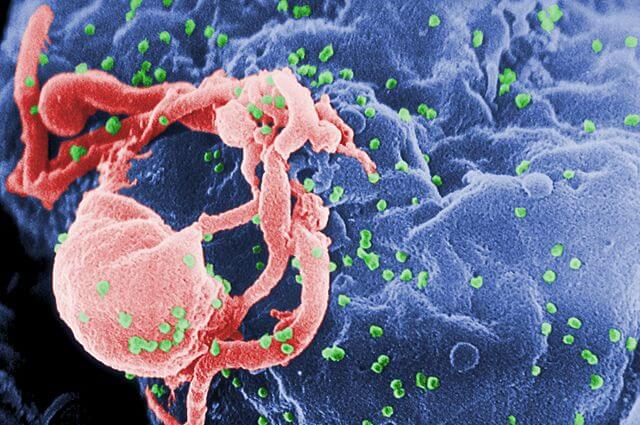At a White House event today to mark the 25th annual World AIDS Day, President Obama announced that the National Institutes of Health plans to redirect AIDS research funds to expand support for research directed toward a cure for HIV. NIH plans to invest an additional $100 million over the next three fiscal years on this increasingly promising area of HIV/AIDS research.
In the three decades since AIDS was first reported, the NIH has been the global leader in research to understand, prevent, diagnose, and treat HIV infection and its many associated conditions. NIH-funded researchers — in partnership with academia and the biotechnology and pharmaceutical industries — have helped develop more than 30 life-saving antiretroviral drugs and drug combinations for treating HIV infection. These antiretroviral drugs have transformed life with HIV infection for those who have access to and can tolerate the therapies. However, treatment requires lifelong access and adherence to these medications and management of treatment-related toxicities and clinical complications.
Important recent advances in basic and therapeutics research aimed at eliminating viral reservoirs in the body are spurring scientists to design and conduct research aimed at a cure or lifelong remission of HIV infection. Key stakeholders from academia, government, foundations, advocacy groups and industry have concluded that developing a cure for HIV is one of the most important biomedical challenges of the 21st century. This will require an extraordinary, collaborative global effort, including public-private partnerships and innovative alliances to share scientific expertise and accelerate the search for a cure.
In a presentation at the White House event today, Anthony S. Fauci, M.D., director of the National Institute of Allergy and Infectious Diseases, the component of NIH with the largest investment in HIV/AIDS research, discussed the public health and scientific rationale for expanded research in this area.
“Although the HIV/AIDS pandemic can theoretically be ended with a concerted and sustained scale-up of implementation of existing tools for HIV prevention and treatment, the development of a cure is critically important, as it may not be feasible for tens of millions of people living with HIV infection to access and adhere to a lifetime of antiretroviral therapy,” Dr. Fauci noted. “Our growing understanding of the cellular hiding places or ‘reservoirs’ of HIV, the development of new strategies to minimize or deplete these reservoirs, and encouraging reports of a small number of patients who have little or no evidence of virus despite having halted antiretroviral therapy, all suggest that the time is ripe to pursue HIV cure research with vigor.”
Funding for these new initiatives will come from existing resources and a redirection of funds from expiring AIDS research grants over the next three years. NIH Director Francis S. Collins, M.D., Ph.D., said, “Flat budgets and cuts from sequestration have had a profound and damaging impact on biomedical research, but we must continue to find ways to support cutting-edge science, even in this environment. AIDS research is an example of an area where hard-won progress over many years has resulted in new and exciting possibilities in basic and clinical science in AIDS that must be pursued.”
Jack Whitescarver, Ph.D., director of the Office of AIDS Research, a component of the Office of the Director of NIH, said, “We have listened very carefully to the scientific consensus of experts from within the NIH and around the world. We have been building the portfolio of HIV cure research over the past few years, and now is the time to accelerate our research focused specifically toward the goal of sustained or lifelong remission, in which patients control or even eliminate HIV without the need for lifelong antiretroviral therapy.”
It is anticipated that a significant portion of the new investment will support basic research, which will also benefit all other areas of AIDS research, as well as research on other diseases. These studies will include research on viral reservoirs, viral latency, and viral persistence, as well as studies of neutralizing antibodies. Research on animal models, drug development and preclinical testing of more potent antiretroviral compounds capable of diminishing viral reservoirs, and clinical research, including studies on therapeutic vaccines and other immune enhancers, will also be supported.
Other high-priority AIDS research will continue to be supported. These priorities include: prevention research, including vaccines, microbicides, and other biomedical and behavioral prevention strategies, such as the use of antiretroviral drugs as prevention; research to develop better, less toxic treatments and to investigate how genetic determinants, sex, gender, race, age, nutritional status, treatment during pregnancy, and other factors, including stigma and adherence, interact to affect treatment success or failure and/or disease progression; and studies to address the increased incidence of malignancies, cardiovascular, neurologic, and metabolic complications, and premature aging associated with long-term HIV disease and antiretroviral treatment. Through all of this research, NIH is committed to the ultimate goal of a world without AIDS.
NIAID conducts and supports research — at NIH, throughout the United States, and worldwide — to study the causes of infectious and immune-mediated diseases, and to develop better means of preventing, diagnosing and treating these illnesses. News releases, fact sheets and other NIAID-related materials are available on the NIAID Web site at http://www.niaid.nih.gov.
The Office of AIDS Research, part of the Office of the Director, plans and coordinates the scientific, budgetary, legislative and policy elements of the NIH AIDS research program. Additional information, including the trans-NIH strategic plan and budget, is available at http://www.oar.nih.gov.



